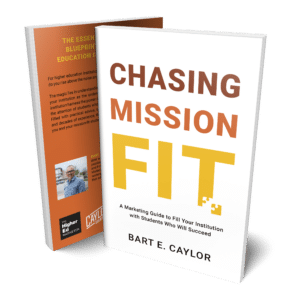Digital Natives and AI: What Higher Ed Can Learn from Gen Z
How can higher ed engage digital natives and cultivate AI fluency at the same time? Conor and Finn Grennan share insights for the next generation of learners.
Marketing Trends
The ROI of AI in higher ed marketing is one of the most misunderstood—and most overlooked—conversations happening on campuses today.
It’s easy to get swept up in the novelty of AI tools or overwhelmed by the hype around automation and efficiency.
But when you’re facing tight budgets, high enrollment pressure, and an exhausted team, what really matters is simple:
Does this actually help?
You’re not looking for another shiny object.
You need tools that reduce workload, improve performance, and make every marketing dollar go further.
And that’s where AI delivers, if you know where to look.
In this post, we’ll uncover the hidden return on investment AI can bring to your marketing strategy, not just in theory, but in measurable outcomes.
We’ll explore five specific areas where AI creates real value for higher ed marketing teams, and we’ll walk through practical ways to track success so you can prove the impact to your leadership.
Whether you’re skeptical or already experimenting with AI, this guide will help you move from uncertainty to clarity, and from curiosity to confidence.
For higher ed marketers, proving ROI isn’t optional. It’s expected.
Your leadership wants to know that every investment moves the needle, especially in an environment where resources are shrinking and expectations are rising.
But AI doesn’t always lend itself to simple ROI calculations… at least not at first glance.
Many of the real gains from using AI tools are indirect: faster content production, better message alignment, improved engagement across platforms.
These don’t always show up in a monthly budget report, but they can make a profound difference in your team’s output and your campaign performance.
A: The ROI of AI in higher ed marketing includes faster content creation, smarter campaign testing, improved audience targeting, and better use of limited resources. AI doesn’t replace your team—it increases their capacity by handling repetitive tasks and enhancing personalization. Over time, these efficiencies add up to real, measurable results in enrollment and engagement.
The ROI of AI in higher ed marketing shows up in the margins.
It’s in the time your team doesn’t spend rewriting email copy.
It’s in the extra bandwidth you gain to think strategically, not just tactically.
And perhaps most importantly, it’s in the cumulative effect of dozens of micro-optimizations—tighter targeting, faster testing, more relevant messaging—that AI makes possible.
Let’s define “return” in realistic terms for higher ed:
This kind of ROI doesn’t always shout.
But over time, it compounds, creating meaningful results that justify your investment not just in AI tools, but in the people who use them wisely.

AI isn’t magic, but when used with purpose, it becomes a force multiplier.
Below are five key areas where colleges and universities are seeing real returns from AI: not just in saved time, but in better outcomes, smarter decisions, and more resilient marketing teams.
For most higher ed marketing teams, content is the bottleneck.
Between blog posts, emails, social media, and landing pages, the demand never lets up—and the pressure to stay relevant with prospective students, donors, and parents is constant.
AI lightens the load.
By using tools like ChatGPT or Jasper to generate first drafts, summarize transcripts, or adapt content for multiple platforms, teams can produce more content in less time.
But it’s not just about volume.
By offloading the first 60% of the creative process, AI gives your team the margin to focus on what really matters: refining messaging, aligning with strategy, and ensuring that every piece reflects your institution’s unique voice.
That’s the real ROI of AI—more quality content, less burnout.
A/B testing has long been a pillar of smart digital marketing.
The challenge?
Creating enough ad variations, subject lines, or CTA copy to test effectively without exhausting your team.
AI solves this by generating rapid variations based on a single prompt.
Whether you’re running digital ads on Meta or Google, or testing open rates for an enrollment email, AI can deliver dozens of options in seconds.
This lets your team test faster, iterate smarter, and improve results without increasing workload.
Think of it this way: AI doesn’t replace your strategist. Rather, it supercharges their insight with faster feedback loops.
The more relevant your message, the better your results.
AI tools can help you define audience segments, develop personas, and customize content for specific groups without building each piece from scratch.
Imagine tailoring an email for Gen Z first-gen students in urban areas…
And another version for their parents…
And another for rural homeschoolers…
That level of personalization used to be out of reach for small teams. But with AI, it’s possible and scalable.
This kind of audience-aware messaging pays off in click-through rates, engagement metrics, and ultimately, applications.
Maintaining a consistent presence across Instagram, LinkedIn, TikTok, email, and your website is a massive challenge.
AI helps you stay present without sacrificing your people.
Tools can generate post copy, summarize student interviews, repurpose blog posts into Instagram carousels, and even adjust tone to match each platform.
The result?
A more active digital presence without burning out your staff.
And because AI can help ensure your content stays aligned with your brand voice (especially with editorial oversight), quality doesn’t have to suffer for scale.
Data overload is a real problem.
Most marketing teams are drowning in dashboards but are short on time to analyze them deeply.
AI can summarize performance data, spot trends in student feedback, or even compare competitor messaging giving your team actionable insights, not just information.
Whether you’re tweaking your enrollment messaging or refining donor outreach, this kind of rapid synthesis leads to smarter decisions and stronger results.
And that’s the kind of ROI that compounds over time.

AI can feel intangible, especially when you’re trying to prove its value to leadership.
But the ROI of AI becomes much clearer when you measure the right things.
Start by shifting the question from, “Did AI save us money?” to “Did AI help us work smarter, faster, or more effectively?”
A: AI saves money by reducing the time and labor needed to create and repurpose content, generate campaign variations, and analyze performance data. It helps small teams do the work of larger ones—without sacrificing strategy or quality. This means more reach, better results, and less budget strain.
Here are five practical indicators to help you track the return on your AI investment:
Even if you can’t tie every benefit to a dollar sign, these indicators build a case for continued investment in AI tools and training.
While tracking ROI, steer clear of these common traps:
A: To measure the ROI of AI, track time saved, content production output, cost-per-lead, conversion rates, and engagement metrics. You should also monitor how AI tools improve speed-to-launch and enable campaign testing at scale. These indicators show how AI contributes to both efficiency and impact.
It’s natural to feel cautious about AI, and all the more so when headlines scream about job loss and automation.
But in higher ed marketing, the real opportunity isn’t in replacing people.
It’s in protecting your people by giving them tools that reduce burnout, streamline repetitive tasks, and free up space for strategic, creative work.
If you’ve ever wondered, “Will AI take my job?”—you’re not alone.
But here’s a better question: “How can AI help me do my job better?”
As we’ve seen with many of our partner institutions, the biggest wins come when AI is used to:
In other words, the ROI of AI isn’t just in what it saves. It’s in what it makes possible.
And when AI becomes a trusted assistant—not a feared adversary—you give your team the bandwidth to lead, not just survive.
The ROI of AI in higher ed marketing isn’t just about doing things faster or cheaper—it’s about doing them smarter.
It’s the margin your team gains when they’re not bogged down by endless content creation.
It’s the agility you unlock when campaigns can pivot based on real-time insights.
It’s the capacity you recover when automation handles the routine and your people focus on what really matters: crafting messages that resonate, telling stories that connect, and building relationships that last.
AI isn’t a silver bullet.
But when integrated thoughtfully, it becomes a competitive advantage, especially for small, resource-strapped teams trying to do more with less.
And in an era where every dollar must deliver, that kind of margin is ROI you can’t afford to ignore.
Turn Strategic Margin into Measurable Momentum
If you’re seeing the potential of AI but still need help turning strategy into action, our Enrollment & Capital Campaigns service is here to bridge that gap.
At Caylor Solutions, we design targeted marketing campaigns that don’t just look good—they perform.
Whether you’re trying to increase student enrollment or rally donor support for a capital initiative, our team builds campaigns that:
✅ Use AI-enhanced insights to reach the right audience
✅ Leverage storytelling that aligns with your mission
✅ Deliver measurable ROI through smarter targeting and clear calls to action
And because we understand the unique demands of higher education, every campaign is crafted with your goals, culture, and capacity in mind.
Your success isn’t just about doing more—it’s about doing what matters most.
Let us help you turn strategic clarity into results you can report on.
👉 Contact Us to Explore Enrollment & Capital Campaign Services
The essential marketing book every higher education institution needs! If you are a higher education marketing professional seeking a fail-safe plan to make your institution stand out, “Chasing Mission Fit” is your guide.
 Discover how to:
Discover how to:
So you can empower your institution with audience-focused marketing strategies, and attract mission-fit students who will flourish in your unique academic environment.
Ready to transform your institution’s marketing approach?
Order now!
Images via Midjourney
Subscribe to The Higher Ed Marketer podcast today!